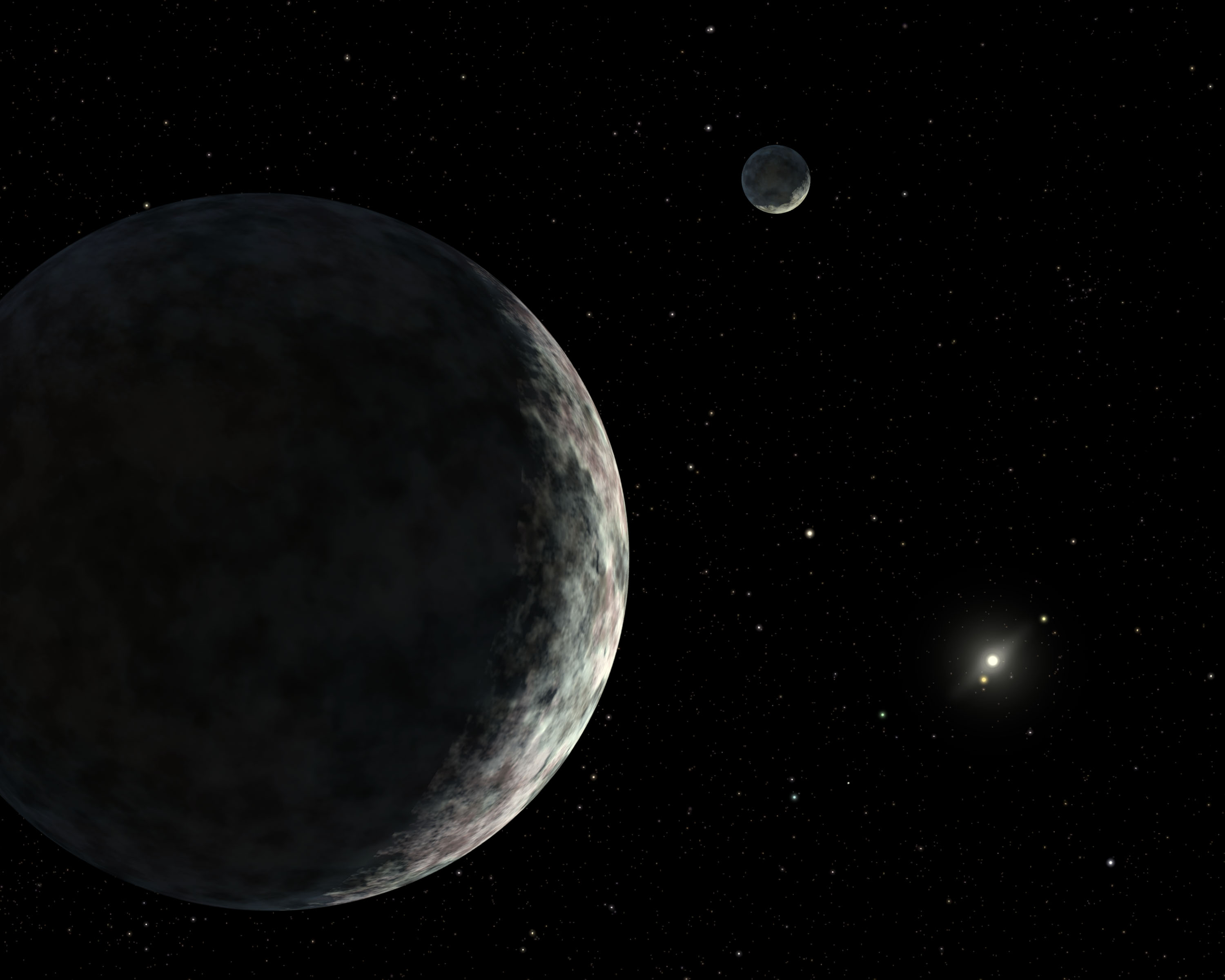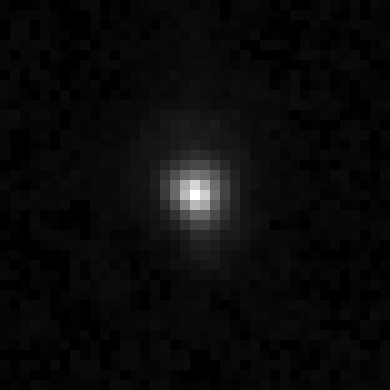







| BOOKS | F. A. Q. | ARTICLES | TALKS | ABOUT KEN | DONATE | BEYOND OUR KEN |
|---|
By Ken Croswell
January 5, 2006

Today, January 5, marks the first anniversary of the discovery of the Sun's tenth planet--the first planet found in our solar system in 75 years.
The planet is presently more than three times farther than Pluto. It is the most distant object ever seen in the solar system.
Michael E. Brown of the California Institute of Technology, Chadwick Trujillo of Gemini Observatory, and David Rabinowitz of Yale University discovered the new planet on January 5, 2005, at 11:20 in the morning, Pacific time. They were reanalyzing data they had taken in October 2003. That's why the tenth planet's designation--2003 UB313--includes the year 2003.
Brown and his colleagues were forced to announce the discovery on Friday afternoon, July 29, 2005, after someone broke into their computer. The break-in raised the threat that someone else might claim credit for the new world.
At the time of the announcement, the astronomers said they had discovered the planet on January 8. But the true date was January 5.
"We apologize for the mistake," Brown says on his website; "it was caused because of the craziness surrounding the first day of announcement. We didn't have time to check our notes and apparently our memories are not as good as they used to be."
| Planet | Discovery Date | Discoverers | |
| Uranus | March 13, 1781 | William Herschel | |
| Neptune | September 23, 1846 | Johann Galle and Heinrich d'Arrest | |
| Pluto | February 18, 1930 | Clyde Tombaugh | |
| Tenth Planet | January 5, 2005 | Michael E. Brown, Chadwick Trujillo, and David Rabinowitz |
The tenth planet still has no name. Its name depends on whether it is classified as a planet. Although the tenth planet is larger than Pluto, some astronomers question Pluto's planetary status. If Pluto is not a planet, then the tenth planet may not be, either.
The problem: Pluto's estimated size has shrunk. After its 1930 discovery, Pluto was thought to be larger than it really is. For many years, it was thought to be halfway in size between Mercury and Mars. Thus, it seemed to be a planet--since no one questions the planetary status of Mercury.
In the 1970s, however, astronomers discovered that Pluto is smaller than Mercury. Today they know its diameter is about half that of Mercury. Still, Pluto is more than twice the diameter of Ceres, the largest asteroid.
Pluto is smaller than seven moons, including our own. But Mercury is smaller than two moons, Jupiter's Ganymede and Saturn's Titan, and nearly as small as a third, Jupiter's Callisto.
 On September 10, 2005, astronomers discovered that the tenth
planet also has a moon. It is the only known planet besides
Earth that has just one moon.
On September 10, 2005, astronomers discovered that the tenth
planet also has a moon. It is the only known planet besides
Earth that has just one moon.
The tenth planet's exact size is unknown. Although it is larger than Pluto, it is probably smaller than Mercury. The newfound moon feels the planet's gravity, so its orbital motion promises to reveal the planet's mass.
Astronomers began discovering solar system objects farther than Pluto in 1992. Such a belt of far-off objects had been predicted by Irish astronomer Kenneth Edgeworth in 1943, then by American astronomer Gerard Kuiper in 1951. Today the Edgeworth-Kuiper belt has about a thousand known members. Of all the many objects in the Edgeworth-Kuiper belt, the tenth planet is the largest; Pluto is the second largest.
Recently, a nineteen-member committee of the International Astronomical Union (IAU) attempted to define "planet" and clarify whether Pluto and the tenth planet are really planets. However, the committee failed to reach a decision.
Committee members voted on three proposals. Each member was free to vote for more than one proposal.
The first proposal is the one children learn in school: the solar system has nine planets from Mercury to Pluto. This definition might imply that the tenth planet is also a planet, since it is larger than Pluto.
This proposal received eleven votes from the nineteen-member committee.
A second proposal suggested classifying planets according to type--for example, calling some of them terrestrial planets and others giant planets. Under this scheme, Pluto and the tenth planet would be considered trans-Neptunian planets, but so would several members of the Edgeworth-Kuiper belt that are smaller than Pluto.
This proposal received eight votes from the nineteen-member committee.
The third and final proposal said the solar system has only eight planets, those from Mercury to Neptune. Under this proposal, neither Pluto nor the tenth planet would qualify as planets.
This proposal received just six votes from the committee.
Whatever it is ultimately called, the tenth planet continues to swing--slowly--around the Sun. Its orbit is quite elliptical, carrying it from 38.2 times the Sun-Earth distance to 97.5 times the Sun-Earth distance. Its average distance from the Sun is 67.9 times the Sun-Earth distance, but it is currently near the far point of its orbit. For comparison, Pluto's mean distance from the Sun is 39.5 Sun-Earth distances, although it is currently closer than this.
Because the tenth planet's orbit is so long, and because it moves so slowly along that orbit, the new world takes a long time to revolve around the Sun. Whereas Pluto orbits the Sun in 248 years, the tenth planet requires 559 years to do the same.
That just might be enough time for astronomers on Earth to figure out what a planet really is.
 Update (April 11, 2006): Using the Hubble Space Telescope, which took the image to the right, Brown and his colleagues have now succeeded in measuring the tenth planet's diameter: 2,400 ± 100 kilometers, about 4 percent larger than Pluto's.
Update (April 11, 2006): Using the Hubble Space Telescope, which took the image to the right, Brown and his colleagues have now succeeded in measuring the tenth planet's diameter: 2,400 ± 100 kilometers, about 4 percent larger than Pluto's.
Thus, the ninth and tenth planets appear to be twin planets--as are Uranus and Neptune, the seventh and eighth planets. Of course, Uranus and Neptune are far larger than Pluto and the tenth planet, but Uranus is only 3 percent larger than Neptune. Also, Uranus and Neptune have similar masses, densities, compositions, and colors.
Pluto's mass, density, and approximate composition are known. Not so for the tenth planet. However, by tracking the tenth planet's moon, astronomers will be able to measure the planet's mass--because the moon feels the planet's gravity, which depends on the planet's mass. Therefore, observing the planet's moon promises to reveal whether Pluto and the tenth planet, like Uranus and Neptune, share similar masses, densities, and compositions.
Update (October 24, 2006): The controversy over planethood remains unresolved. On August 16, 2006, a seven-member committee released a proposal it had voted for unanimously. This proposal would have preserved the planethood of Pluto and the tenth planet but also would have bestowed planethood on Ceres, the largest asteroid; Charon, Pluto's largest moon; and dozens of other objects in the solar system. Under this proposal, even the Moon would someday be deemed a planet, when it strayed sufficiently far from the Earth that the center of mass of the Earth-Moon system lay outside the Earth.
The extreme proposal provoked an equally extreme reaction. On August 24, 2006, a few hundred astronomers at the IAU voted to reject the proposal, not only sweeping Ceres and Charon from their 15 minutes of planetary fame but also casting Pluto and the tenth planet into the cold. Sky and Telescope published a mnemonic for this eight-planet solar system: Many Very Egotistical Malcontents Just Screwed Up Nomenclature.
A week after the IAU vote, 304 astronomers signed a petition rejecting it. "We, as planetary scientists and astronomers, do not agree with the IAU's definition of a planet nor will we use it," the petition read. "A better definition is needed."
Perhaps the only good thing to emerge from the mess has been a name for the tenth planet. In September 2006, the discoverers christened it Eris, for the mythological goddess of strife and discord. They named Eris's moon Dysnomia, the daughter of Eris and the demon spirit of lawlessness.
Centuries ago, Eris made a contribution to the English language. According to Merriam-Webster's Collegiate Dictionary, the word eristical means "characterized by disputatious and often subtle and specious reasoning."
No illustration currently accompanies the dictionary definition of eristical. So astronomers may want to keep a low profile the next time the Merriam-Webster artist swings through town.
Update (December 11, 2006): A free fact sheet--"Is Pluto a Planet?"--presenting arguments both for and against Pluto's planethood is now available online. This is a PDF file that may require two minutes to download.
Ken Croswell is an astronomer and the author of Magnificent Universe and Ten Worlds: Everything That Orbits the Sun, which devotes a full chapter to Pluto and also to Eris.
"Magnificent Universe by Ken Croswell is elegant and eloquent."--Kathy Sawyer, Washington Post. See all reviews of Magnificent Universe here.
"Ten Worlds is a hit on all counts: it's engaging, well written, and--most importantly--accurate. I was most impressed with how up-to-date it is. All of the latest exciting scientific discoveries are included, along with the best of the new pictures."--Dr. Michael E. Brown, discoverer of Eris. Read more about Ten Worlds here.
| BOOKS | F. A. Q. | ARTICLES | TALKS | ABOUT KEN | DONATE | BEYOND OUR KEN |
|---|